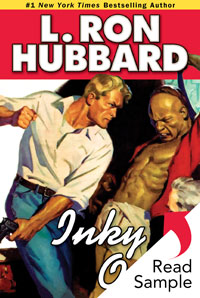Bat Conroy—cut him and he’d bleed ink, he’s a born newspaperman. The greatest American journalists of the 20th century all made their names as war correspondents, but none of them would have beat out Bat Conroy to a good story.
Which makes it that much more mystifying—and aggravating—when an unknown writer, filing under the byline Perry Lane, scoops Bat on every story that comes along. Bat’s always been the go-to reporter covering the Japanese invasion of China … until this Perry Lane person came along to steal his thunder and maybe even his job.
Now, the biggest story of the war is about to hit the fan, and Bat’s going to get to the source first if it kills him. But the most shocking news of all is the true identity of the elusive Perry Lane.
SAMPLE

ABOUT THE AUTHOR
As a young man, L. Ron Hubbard visited Manchuria, where his closest friend headed up British intelligence in northern China. Mr. Hubbard gained a unique insight into the intelligence operations and spy-craft in the region as well as the hostile political climate between China and Japan—a knowledge that informs stories like Inky Odds.
Inky Odds Glossary
Stories from the Golden Age reflect the words and expressions used in the 1930s and 1940s, adding unique flavor and authenticity to the tales. While a character’s speech may often reflect regional origins, it also can convey attitudes common in the day. So that readers can better grasp such cultural and historical terms, uncommon words or expressions of the era, the following glossary has been provided.
Australian honey bear: a koala.
binnacle: a built-in housing for a ship’s compass.
blackguard: a man who behaves in a dishonorable or contemptible way.
brass cash: any of various Asian coins of small denomination with a square hole in their center.
bug: a high-speed telegrapher’s key that makes repeated dots or dashes automatically and saves motion of the operator’s hand.
Bund: the word bund means an embankment and “the Bund” refers to a particular stretch of embanked riverfront along the Huangpu River in Shanghai that is lined with dozens of historical buildings. The Bund lies north of the old walled city of Shanghai. This was initially a British settlement; later the British and American settlements were combined into the International Settlement. A building boom at the end of the nineteenth century and beginning of the twentieth century led to the Bund becoming a major financial hub of East Asia.
camion: a low flat four-wheeled truck.
carabao: water buffalo.
Changkow: Kaingsu or Jaingsu Province; a province of China, located along the east coast of the country, on the Yellow Sea.
Chiang Kai-shek: (1887–1975); military leader of the Chinese Nationalist Party that attempted to purge Communism from China and unite the country under one central government. Civil war broke out in 1927 between the Nationalist government and the Red Army led by Mao Tse-tung. China was also involved in intermittent conflicts with Japan since 1931, with full-scale war breaking out in 1937. In 1949, the Nationalist government’s power declined and Communist control ensued, forcing the Nationalists from mainland China into Taiwan.
Cochin China: a region covering southern Vietnam. Originally part of the Chinese empire, it was made a French colony in 1867 and combined with other French territories to form French Indochina in 1887 with Saigon as its capital. It was incorporated into Vietnam in 1949.
davits: any of various cranelike devices, used singly or in pairs, for supporting, raising and lowering boats, anchors and cargo over a hatchway or side of a ship.
dazzle-painted: something painted with dazzle camouflage; a camouflage paint scheme of complex geometric shapes in contrasting colors. Its purpose was not concealment but to make it difficult to estimate the target by creating a confusion with rangefinders that operated by lining up two half-images of the target. Dazzle camouflage was intended to make it hard to do this job because the clashing patterns would not look right in the rangefinder sights even when aligned.
dog bites man: the phrase comes from a quote attributed to New York Sun editor John B. Bogart (1845–1921): “When a dog bites a man, that is not news, because it happens so often. But if a man bites a dog, that is news.”
drome: short for airdrome; a military air base.
emplacements: prepared positions for weapons or military equipment.
fo’c’s’le: forecastle; the upper deck of a sailing ship, forward of the foremast.
Forbidden City: a walled enclosure of central Peking, China, containing the palaces of twenty-four emperors in the Ming (1364–1644) and Qing (1644–1911) dynasties. It was formerly closed to the public, hence its name.
foredeck: the part of a ship’s deck between the bridge and the forecastle (the upper deck of a sailing ship, forward of the foremast).
Frisco: San Francisco.
G-men: government men; agents of the Federal Bureau of Investigation.
Gobi: Asia’s largest desert, located in China and southern Mongolia.
godown: a warehouse; a commercial building for storage of goods.
Gulliver in Brobdingnag: refers to a satire, Gulliver’s Travels, by Jonathan Swift, in 1726. Lemuel Gulliver, an Englishman, travels to exotic lands, including Lilliput (where the people are six inches tall), Brobdingnag (where the people are seventy feet tall), and the land of the Houyhnhnms (where horses are the intelligent beings, and humans, called Yahoos, are mute brutes of labor).
holdout: playing cards hidden in a gambling game for the purpose of cheating.
jane: a girl or a woman.
Kalgan: a city in northeast China near the Great Wall that served as both a commercial and a military center. Kalgan means “gate in a barrier” or “frontier” in Mongolian. It is the eastern entry into China from Inner Mongolia.
Kawasaki: aircraft named after its manufacturer. Founded in 1918, Kawasaki built engines and biplanes in the 1930s, including fighters and bombers.
key: a hand-operated device used to transmit Morse code messages.
Legation Street: also known as the Legation Quarter; it was encircled by a wall and was a city within Peking exclusively for foreigners. It housed eleven foreign embassies and was off-limits to Chinese residents.
limber: a two-wheeled, horse-drawn vehicle used to tow a field gun or an ammunition box.
Manchuria: a region of northeast China comprising the modern-day provinces of Heilongjiang, Jilin and Liaoning. It was the homeland of the Manchu people, who conquered China in the seventeenth century, and was hotly contested by the Russians and the Japanese in the late nineteenth and early twentieth centuries. Chinese Communists gained control of the area in 1948.
Mariveles: a town and the mountains located in the southern part of the Bataan Peninsula on Luzon, the chief and largest island of the Philippines.
Mex: Mexican peso; in 1732 it was introduced as a trade coin with China and was so popular that China became one of its principal consumers. Mexico minted and exported pesos to China until 1949. It was issued as both coins and paper money.
Mikado: the emperor of Japan; a title no longer used.
Mindanao: the second largest and easternmost island in the Philippines.
monte: a card game in which two cards are chosen from four laid out face up, and a player bets that one of the two cards will be matched in suit by the dealer before the other one.
newshawk: a newspaper reporter, especially one who is energetic and aggressive.
one-pounder: a gun firing a one-pound shot or shell. It looks somewhat like a miniature cannon.
Panay: USS Panay, a gunboat responsible for patrolling the Yangtze River to protect American lives and property. In 1937 Panay evacuated the remaining Americans from the city of Nanking after Japanese forces moved in on the city. While upstream the Panay was bombed and sunk, killing three men and wounding forty-three others. Japan claimed that they did not see the US flags painted on the deck of the gunboat, apologized and paid for loss and damages.
Peking: now Beijing, China.
Route Army: a type of military organization exercising command over a large number of divisions. It was a common formation in China but was discarded after 1938.
Scheherazade: the female narrator of The Arabian Nights, who during one thousand and one adventurous nights saved her life by entertaining her husband, the king, with stories.
scow: an old or clumsy boat; hulk; tub.
screw: a ship’s propeller.
Shanghai: city of eastern China at the mouth of the Yangtze River, and the largest city in the country. Shanghai was opened to foreign trade by treaty in 1842 and quickly prospered. France, Great Britain and the United States all held large concessions (rights to use land granted by a government) in the city until the early twentieth century.
SS: steamship.
steerageway: the minimum rate of motion sufficient to make a ship or boat respond to movements of the rudder.
stew-bum: an old hobo wasted by alcohol.
Sulu Islands: island chain in the southwest Philippines.
tetrachloride bombs: white smoke bombs; such bombs are made from chemical compounds and are for use in signaling or screening.
texas: a structure on a river steamboat containing the pilothouse and the officers’ quarters, so called because steamboat cabins were named after states. At one time Texas was the largest state, and as the officers’ quarters were the largest, they were called texas.
tracer: a bullet or shell whose course is made visible by a trail of flames or smoke, used to assist in aiming.
transom: transom seat; a kind of bench seat, usually with a locker or drawers underneath.
White Russian: a Russian who fought against the Bolsheviks (Russian Communist Party) in the Russian Revolution, and fought against the Red Army during the Russian Civil War from 1918 to 1921.
wing collar: a shirt collar, used especially in men’s formal clothing, in which the front edges are folded down in such a way as to resemble a pair of wings.
Yangtze: Yangtze Kiang; the longest river in Asia and the third longest in the world, after the Nile in Africa and the Amazon in South America.
Zamboanga: province and port city in the Philippines, on the island of Mindanao.












